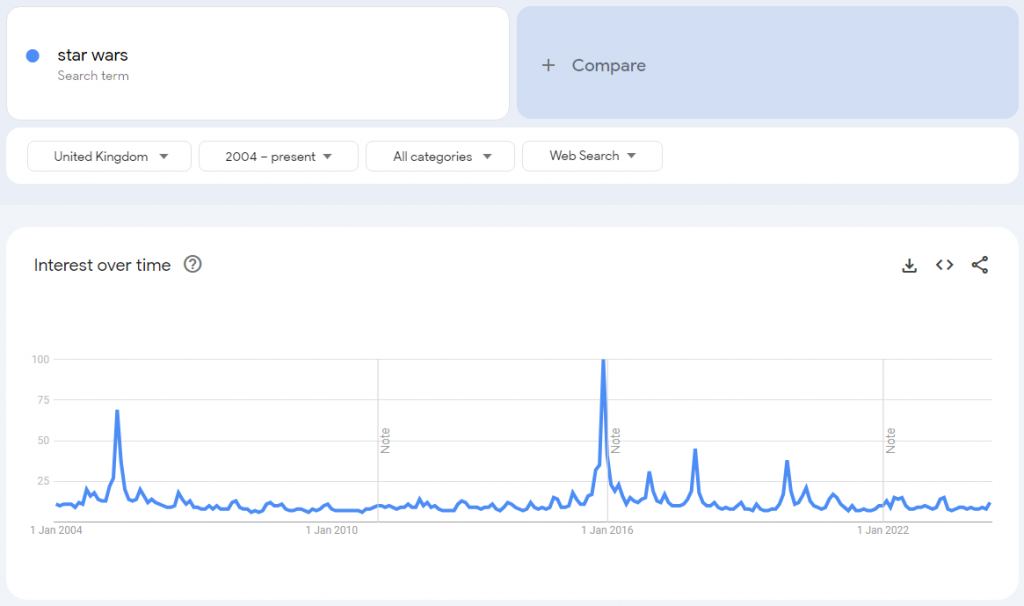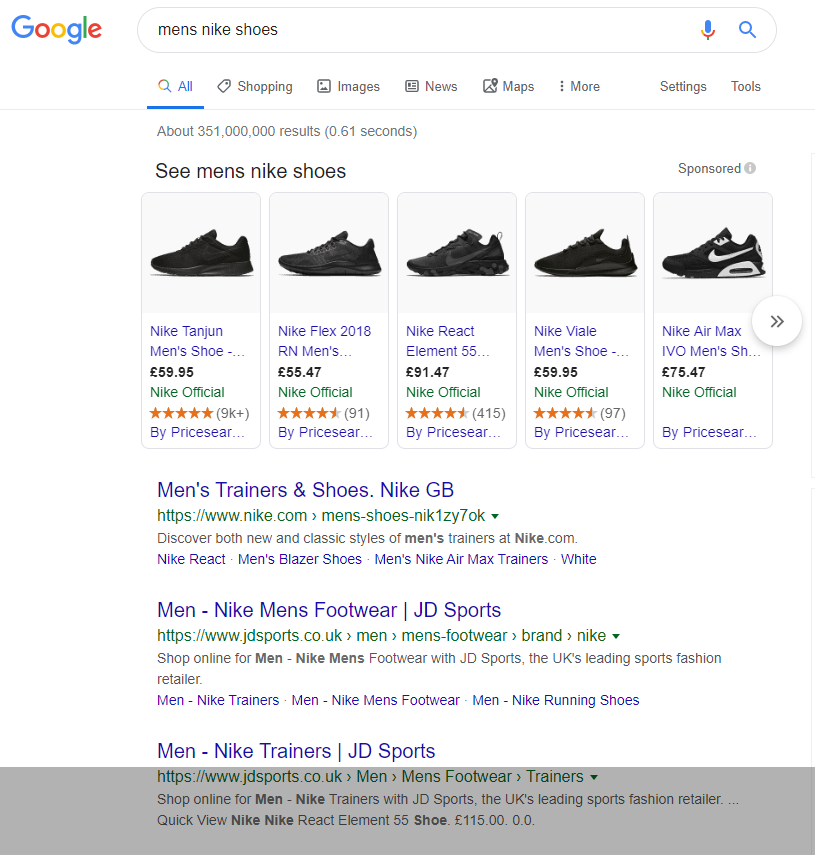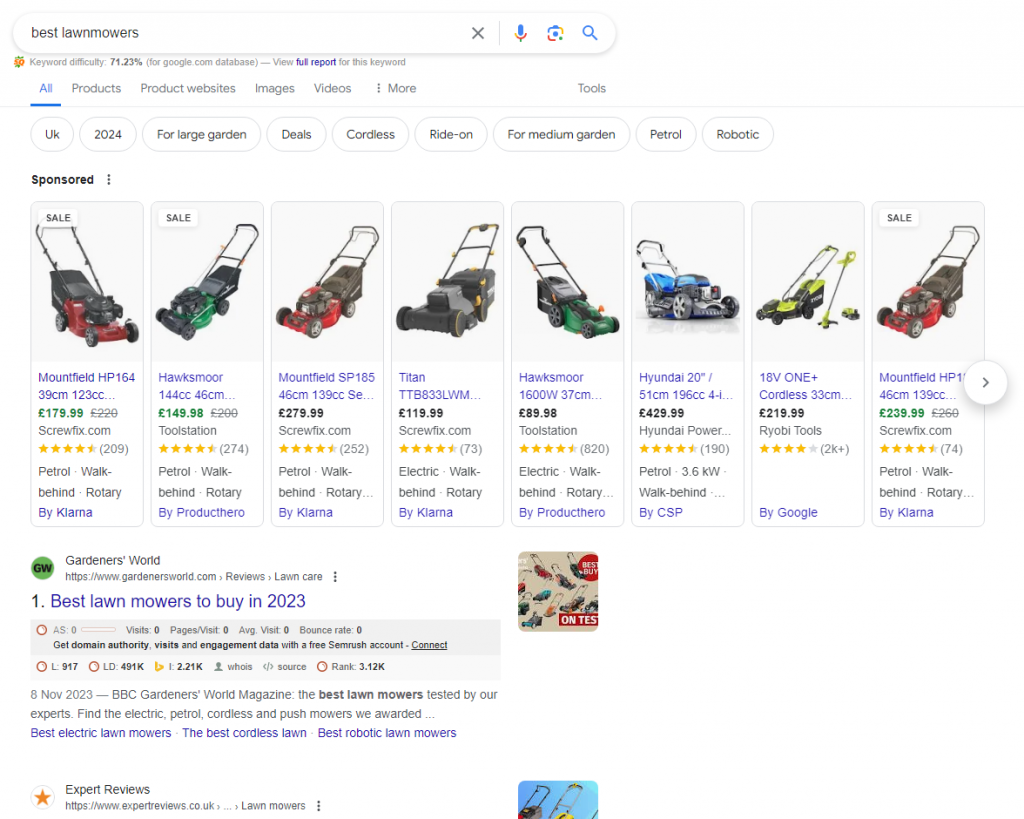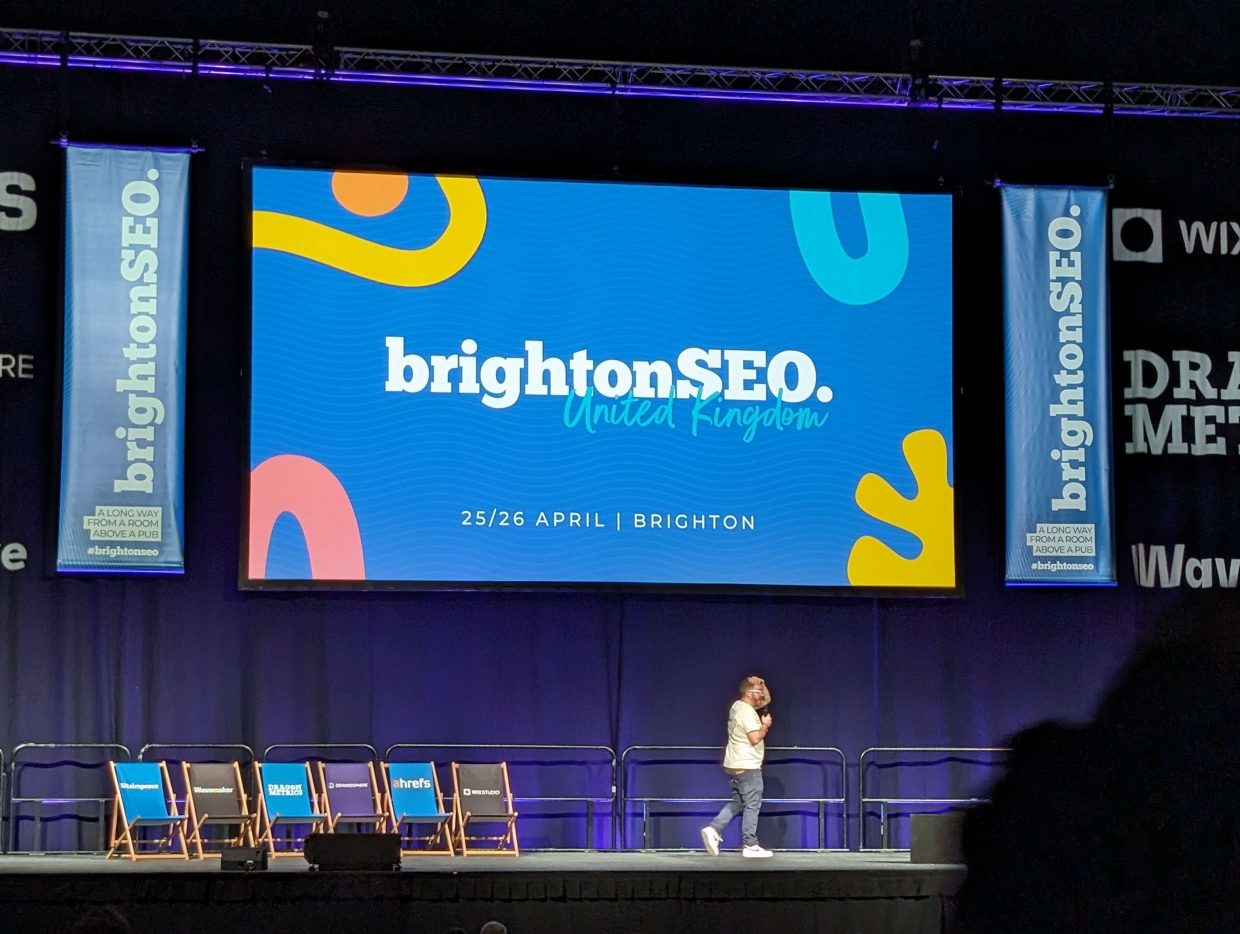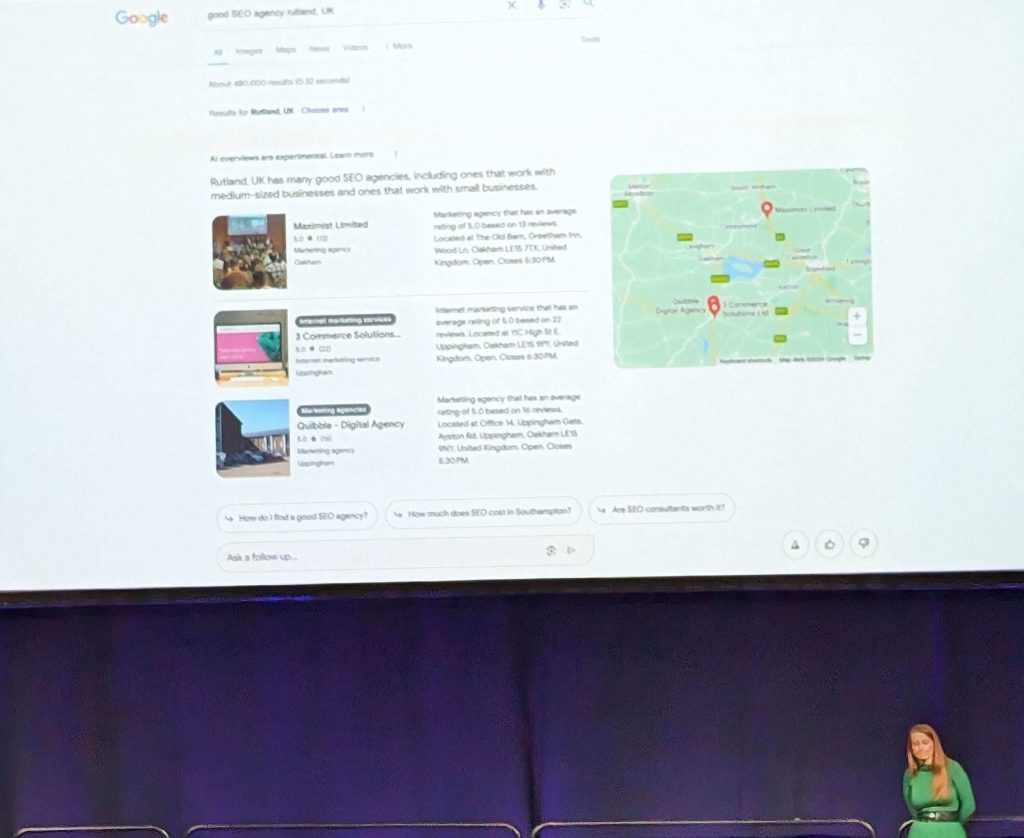How to Choose Keywords for SEO in 2024
Targeting and tracking the right keywords brings your site the most relevant traffic possible.
On the surface, choosing keywords for SEO might seem simple. If your website sells shoes, surely it should be as easy as optimising your website around the keyword “shoes”?
Not quite. The single word “shoes” is searched 90,500 times per month on average, and results pages are dominated by big-name retailers such as Office, Schuh and Asos.
It is extremely difficult to compete for the top spot on these general search terms, but keyword research can help find more effective queries to target.
To choose keywords that will be effective for your business, you must do keyword research (or use a keyword research service). During this research, SEO experts consider:
- Search volume
- Relevance to your business
- Competition
- User Search Intent
- Keyword types, such as Long-Tail keywords
Here’s our starting guide for choosing SEO keywords that are best for your website.
What are SEO keywords?
Keywords (sometimes known as search terms or key phrases) are words and phrases that users enter into a search engine to return a set of results.
SEOs use keywords to define web pages and help target content to the largest and most relevant audience possible.
By understanding the keywords that people use to find products and services like yours, you can optimise your website to capture as much relevant search traffic as possible.
Find the right keywords through keyword research.
Search Volume
Search volume is the total number of searches for a given keyword.
For example: according to the latest data, the keyword “star wars” gets an average of 110,000 searches a month in the UK. But how many of those 110,000 are looking for Star Wars toys, merchandise, streaming or just general information about the movies? Judging by the peaks that coincide with release dates in 2005, 2016, 2017 and 2019, it’s information about the movies.
While it is important to target keywords with the highest search volume possible, balance search volume with relevance to your brand and offering.
Keyword Relevance
Relevant traffic will come from users who are looking for the exact information or product your website is providing. They are more likely to buy from you than those who looking for something else.
Although a keyword may have high search volume and low competition, it’s not worth targeting unless it matches the content your website is offering. Otherwise, it won’t bring in useful traffic.
High search volumes often appear for terms with ambiguous intent. Understanding more specific search terms helps you understand the phrases ideal customers are using to find products like yours.
For example: imagine you have an eCommerce site that sells running shoes designed for gym and exercise use.
Tracking and targeting the keyword “shoes” would not be worthwhile. Although it has a high search volume, this keyword is too general and may draw users whose search intent doesn’t match the specific content your page provides.
“Running shoes”, “Gym shoes”, and “shoes for the gym” are all key phrases that have a stronger association with your product.
Research specific terms that describe your product or service well.
Keyword Intent / Search Intent
Understanding why a user is making a search is vital for SEO – are they looking for a specific product? Do they just need some information on an event? Are they looking for contact details?
There are four types of searches (according to Google)
Navigational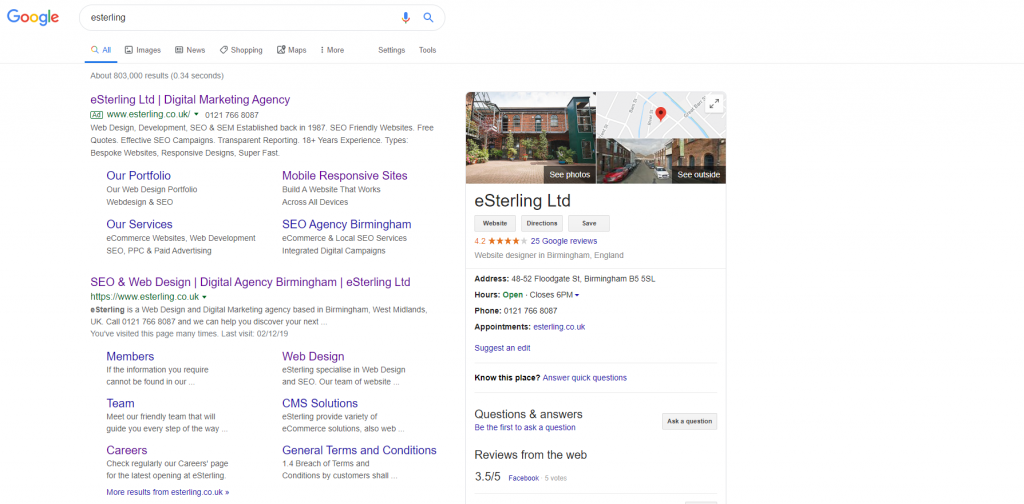
The intent is to reach a particular website or brand. Navigational searches could be terms such as “amazon” or “nike running shoes”.
Informational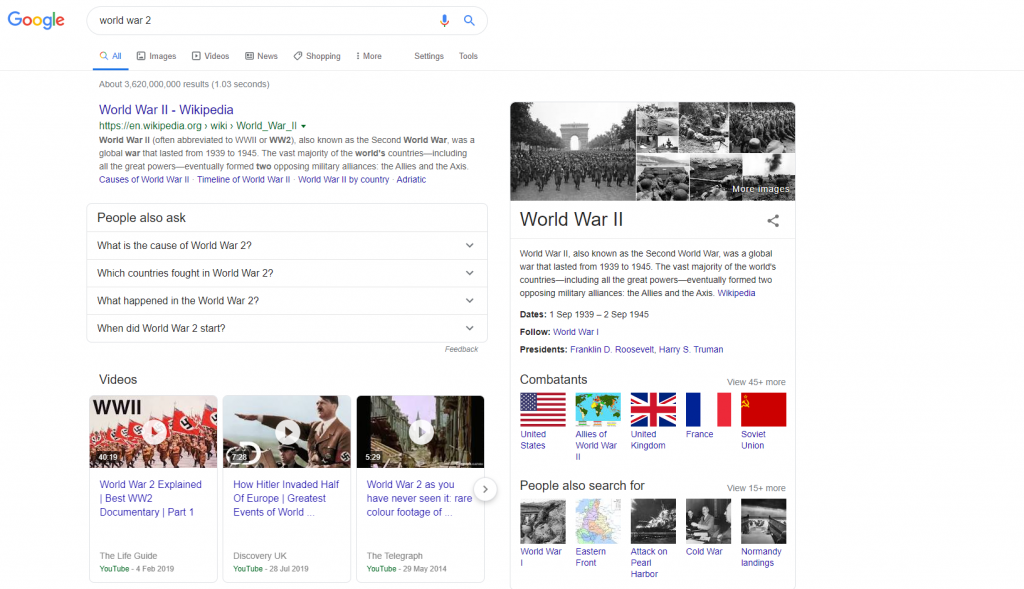
Informational searches are when users are looking for guidance, background information, or specific information about a topic or product without having any concrete intention to purchase or any wish to seek out a specific page.
Transactional
Search requests that indicate a clear intention to purchase are regarded as transactional queries.
Commercial
This is a more recent addition, and describes search terms used by those who want to compare different options before making a purchase.
Commercial search term users are higher up the customer journey funnel than those using ‘Transactional’ search terms, so these queries often return comparison articles, reviews and testimonials.
Through machine learning, Google attempts to understand the intent of searches and returns results that are the closest match to this intent. By looking at the results for a certain keyword, you can get an idea of what a user’s intentions are when they use it.
This is important when choosing keywords. Commercial and Transactional search terms are worth targeting and tracking to increase business.
Keyword Competition
It’s important to consider which competitors are appearing for your chosen keywords. If the first page of Google is dominated by Amazon, eBay or equally as large companies, it may be difficult to outrank these sites.
This isn’t to say it’s impossible but, especially in the early days of an SEO campaign, it may be better to focus your efforts on less competitive keywords.
Research similar-sized competitors and see what keywords generate organic traffic for them. Do you rank for these keywords?
Long-Tail Keywords
Long-tail keywords are longer, specific phrases that narrow down the pool of results.
They are less competitive than shorter keywords, and although they have lower search volume, those using them are more likely to convert to purchase than those using shorter terms.
While your main pages should target simple, high-volume terms that match your products, long-tail keywords provide quality traffic that is extremely relevant. They also help you stand out from your competitors who are only targeting generic shorter terms.
To return to our example of the eCommerce running shoes site, examples of long-tail keywords would include:
- “Running shoes for gym size 5”
- “Ladies black running shoes”
- “Good workout shoes for the gym”
- “Trainers for weightlifting and cardio”
Target long-tail keywords with subheadings on your main pages or content in your blog section.
If you are still having trouble choosing the best SEO keywords, contact eSterling.
As part of our SEO services, we use industry-leading keyword research tools to uncover exactly what you need to target to bring in the most traffic possible.
Give us a call on 0121 766 8087 to discuss how we can help your website reach more people.
BrightonSEO Lessons: Content Strategy in 2024
Our team travelled to Brighton for the biggest SEO conference in the world: BrightonSEO. It’s come a long way from a room above a pub, they say…
Because of the sheer quantity of talks, tips and strategies shared at this event, we can’t include everything. This is the first blog in a new series which will cover the most interesting insights, organised by topic. First, we’ll look at content strategy.
What kind of content will you focus on? How much of it will you produce? Across which platforms? How will you measure success?
A good content strategy is:
- Informed by current content performance
- Targeted using audience profiles
- Time-bound and Measurable
New Thinking on Content Strategy
With the launch of Google SGE coming this month, and search intent forming a much bigger part of the picture than in previous years, there is a lot to discuss this year. The main question on our minds was:
“How do we plan content that creates resilient organic traffic for our clients during all this change?”
Three speakers in the Content Strategy session had different takes on what SEO content writers should prioritise.
1. Preparing for Google SGE
Anna Morrish of Quibble shared content strategies for AI-integrated search. Google SGE will show AI-generated answers before organic website results. As a result, SEO’s are currently analysing how to mitigate losses in organic traffic, which Morrish says may drop by 20-60% in May 2024.
From analysing results during the SGE trial period, Morrish suggests the main areas to focus on will be category content and Google reviews. These are the main decision-making areas that are summarised by SGE, with links to information sources included in the answers.
Using ‘labyrinth movie gifts’ as a sample search query, Morrish demonstrated that SGE will suggest various expansions of the query by category. If category content on eCommerce sites lists helpful information that other providers don’t, the SGE may list your categories over others and cite your website as a source.
She also showed that local business reviews appear as a summary in Google SGE. Like category content, if your Google Reviews include specific language about services, the SGE experience will be more effective.
We’re looking at the questions audiences are asking about our clients’ products and services to understand content gaps and create content to fill them.
Research from STAT (Moz) points to a net benefit for SEOs. The data suggests that users in the US rarely see SGE results by default. Instead, they are triggered by “Generate” buttons, giving users control.
This means the top 5 results will not be completely obscured by the “Generate” button, so your high-ranking pages will still have value.
They also found that sites referenced in 55% of SGE results “did not actually appear in the top 10 organic results for the same SERP.” As we know from the introduction of Featured Snippets and People Also Asked, search users look around for context, even when Google is feeding them key information directly. Lower-ranking pages with specific and useful information may still gain clicks as citations in the SGE’s references.
3 key tips to prepare websites for Google SGE:
Here’s how we can make sure websites are ready for this AI integration and minimise drops in organic traffic.
- Keep content short and to the point.
- Make it personal where possible
- Encourage specific reviews for local businesses
The introduction of AI content isn’t necessarily going to cause a huge shift in metrics. SGE will only appear for users who log into a Google account in their browser, and won’t necessarily show up automatically. This feature is not yet available to more than a ‘small slice’ of UK users, so stay tuned for more detail as the roll-out progresses this month.
2. Target Users who are Ready to Buy with Comparison Posts
Araminta Robertson of Mint Studios shared data on real content that mentions competitors without directing traffic away. Conventional wisdom has been that writing about competitors will simply make users aware of other options and potentially lose sales. Robertson skewers this logic as old-fashioned.
“Customers already know about your competitors” she says, and backs it up:
- They’re doing 3x the research they were doing in the 2010s
- They’re seeing targeted ads the second they start searching for products like yours
- With smartphones, searching multiple sites and products at once is quicker and easier.
Robertson’s rationale for prioritising comparisons was convincing: Comparison posts double conversion rates, and double the size of the deals they lead to. 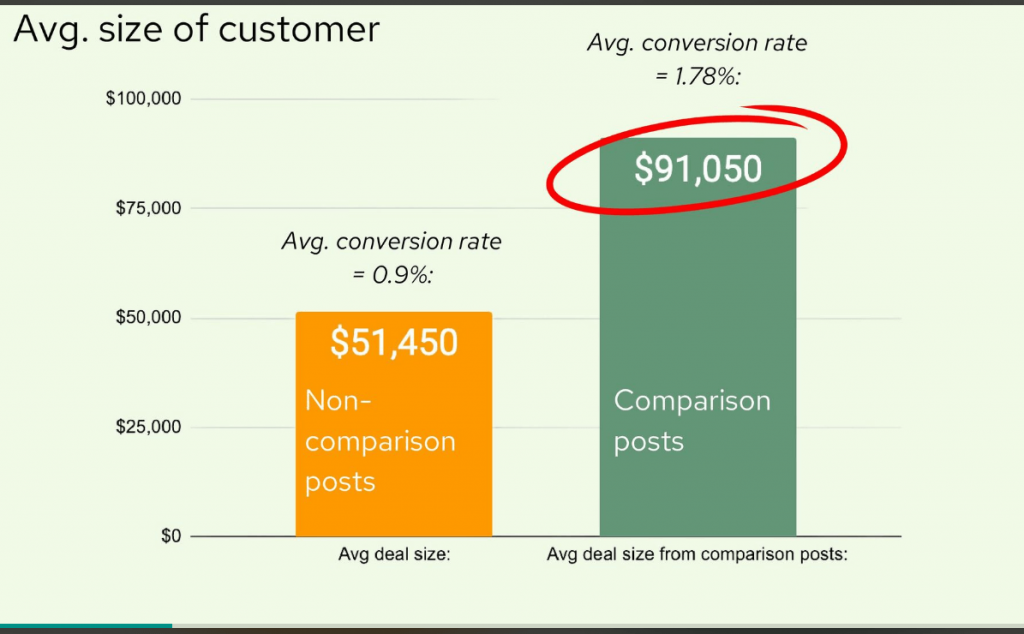
This is because comparing your solution to your competitors’ targets people who are ready to buy. At this funnel stage, people crave comparisons, as shown by the success of sites like Compare the Market.
Why does this work?
Giving potential buyers a direct comparison between your product and a competitor’s alternative saves them time and cognitive energy.
“You don’t want to write an article that says “Our product is the best” full stop.”
The key is to show the situation in which your solution is best. Robertson suggests structuring the article into three parts.
- First, make a solid case for your product. Use technical details, the problems it solves, and testimonials to show why this product works for the situation.
- Give the straightforward facts of a competitor’s product. You can avoid being overly negative or critical, and you can show the situations in which these products might surpass your own.
- Do the same for a third competitor. Give just the facts.
To Make Comparison Posts Work: Name the Elephant
Robertson also advised writers to build trust with the reader by “naming the elephant in the room”: bias.
By being up-front and acknowledging that we think our product is the best, we can disarm the reader’s cynicism. This helps them assess the products with more openness and presents your brand as honest and down to earth.
3. Sustainable Content is Better SEO
Fiona Brennan of Indie Essentials broke the silence on the environmental impact of server farms. To sustain the internet as it is, with 15 million pieces of content (or 328.77 million terabytes of data) generated daily, millions of servers are running day and night. This uses energy and creates an enormous carbon footprint.
Brennan argued that creating huge volumes of content on every conceivable channel is also unsustainable in human terms, sharing that 50% of content writers are burnt out.
The solution to both of these issues is to create less. Instead:
- Optimise existing content. Use what you have before creating more.
- Improve CRO to make the pages that perform well bring people to the products.
- Reduce your channels to include only the channels that make sense for your target market.
- Don’t be afraid to pivot future messaging towards the audience you’re gaining, rather than trying to target everyone.
We already know that with content, less is more. It’s with gratitude that we share Brennan’s approach as a people-first strategy for content creators as well as internet users.
Content Strategy is Changing: for the better.
We’re relieved, frankly, that SEO content doesn’t need to be long-form, rehashing existing information or produced ad infinitum anymore. It’s exhausting, for content writers and SEOs alike. The new content strategy ushered in by the Helpful Content Update, SGE and anti-spam policies favours lean, specific and informative writing.
When we rewrite content for a client’s website, we start with a content audit. By creating an inventory and analysing each page, we can prioritise high-value pages that need work. Out-of-date, irrelevant pages, such as old blog posts, can be pruned or updated, and any new content is as lean as possible.
A few years ago, the conventional wisdom was to add as much content as possible. This means most websites that have had SEO in the past may need to reduce and distil the information they display to continue seeing good results.
If your website’s rankings have been declining, get in touch for an SEO audit with eSterling.

